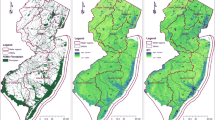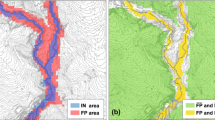Abstract
Land use planners and drainage engineers require, among other information, a clear map that delineates land subject to flash flooding before they can approve residential development. Through the application of spatially distributed models, the topographic wetness index (TWI) can be determined as an alternative to the traditional approach of delineating flood-prone areas using contours alone. The TWI provides a more cost-efficient approach to flood determination than conventional hydrodynamic models. This paper describes an application of the TWI approach to a flood-prone study area in the town of Inverloch, Victoria, Australia. The TWI proved useful in the early stages of land use planning for residential development in Inverloch.










Similar content being viewed by others
References
Barling, R. D., Moore, I. D., & Grayson, R. B. (1994). A quasi-dynamic wetness index for characterizing the spatial distribution of zones of surface saturation and soil water content. Water Resources Research, 30(4), 1029–1044.
Beven, K., & Kirkby, M. (1979). A physically based, variable contributing area model of basin hydrology/Un modèle à base physique de zone d’appel variable de l’hydrologie du bassin versant. Hydrological Sciences Journal, 24(1), 43–69.
Böhner, J., & Selige, T. (2006). Spatial prediction of soil attributes using terrain analysis and climate regionalisation. Böhner, J., Mccloy, KR & J. STROBL (Eds.): SAGA–Analyses and modelling applications.–Göttinger Geographische Abhandlungen, 115, 13–28.
Djokic, D., & Maidment, D. R. (1991). Terrain analysis for urban stormwater modelling. Hydrological Processes, 5(1), 115–124. doi:10.1002/hyp.3360050109.
Freeman, T. G. (1991). Calculating catchment area with divergent flow based on a regular grid. Computers & Geosciences, 17(3), 413–422.
Grabs, T., Seibert, J., Bishop, K., & Laudon, H. (2009). Modeling spatial patterns of saturated areas: a comparison of the topographic wetness index and a dynamic distributed model. Journal of Hydrology, 373(1), 15–23.
Hjerdt, K., McDonnell, J., Seibert, J., & Rodhe, A. (2004). A new topographic index to quantify downslope controls on local drainage. Water Resources Research, 40(5), W05602.
Kopecký, M., & Čížková, Š. (2010). Using topographic wetness index in vegetation ecology: does the algorithm matter? Applied Vegetation Science, 13(4), 450–459.
Lewis, G., & Holden, N. M. (2012). A comparison of grid-based computation methods of topographic wetness index derived from digital elevation model data. Biosystems Engineering Research Review, 17, 103.
Maidment, D. R. (2002). ArcHydro: GIS for water resources. New York: ESRI, Inc.
Manfreda, S., & Sole, A. (2013). Closure to “Detection of flood-prone areas using digital elevation models” by Salvatore Manfreda, Margherita Di Leo, and Aurelia Sole. Journal of Hydrologic Engineering, 18(3), 362–365.
Manfreda, S., Sole, A., & Fiorentino, M. (2008). Can the basin morphology alone provide an insight into floodplain delineation? WIT Transactions on Ecology and the Environment, 118, 47–56.
Manfreda, S., Di Leo, M., & Sole, A. (2011). Detection of flood-prone areas using digital elevation models. Journal of Hydrologic Engineering, 16(10), 781–790.
Nguyen, T. T. M., & Wilson, J. P. (2010). Sensitivity of quasi-dynamic topographic wetness index to choice of DEM resolution, flow routing algorithm, and soil variability.
Pan, F., Peters Lidard, C. D., Sale, M. J., & King, A. W. (2004). A comparison of geographical information systems–based algorithms for computing the TOPMODEL topographic index. Water resources research, 40.
Pei, T., Qin, C. Z., Zhu, A., Yang, L., Luo, M., Li, B., et al. (2010). Mapping soil organic matter using the topographic wetness index: a comparative study based on different flow-direction algorithms and kriging methods. Ecological Indicators, 10(3), 610–619.
Qin, C. Z., Zhu, A. X., Pei, T., Li, B. L., Scholten, T., Behrens, T., et al. (2011). An approach to computing topographic wetness index based on maximum downslope gradient. Precision Agriculture, 12(1), 32–43.
Quinn, P., Beven, K., Chevallier, P., & Planchon, O. (1991). The prediction of hillslope flow paths for distributed hydrological modelling using digital terrain models. Hydrological Processes, 5(1), 59–79.
Ruhoff, A. L., Castro, N. M. R., & Risso, A. (2011). Numerical modelling of the topographic wetness index: an analysis at different scales. International Journal of Geosciences, 2(4), 476–483.
Sørensen, R., & Seibert, J. (2007). Effects of DEM resolution on the calculation of topographical indices: TWI and its components. Journal of Hydrology, 347(1), 79–89.
Sörensen, R., Zinko, U., & Seibert, J. (2006). On the calculation of the topographic wetness index: evaluation of different methods based on field observations. Hydrology and Earth System Sciences Discussions, 10(1), 101–112.
Western, A. W., Grayson, R. B., Blöschl, G., Willgoose, G. R., & McMahon, T. A. (1999). Observed spatial organization of soil moisture and its relation to terrain indices. Water Resources Research, 35(3), 797–810.
Wilson, J. P., & Gallant, J. C. (2000). Digital terrain analysis. Terrain analysis: Principles and applications, 1–27.
Wolock, D. M., & McCabe, G. J. (1995). Comparison of single and multiple flow direction algorithms for computing topographic parameters in TOPMODEL. Water Resources Research, 31, 1315–1324.
Yong, B., Ren, L. L., Hong, Y., Gourley, J. J., Chen, X., Zhang, Y. J., et al. (2012). A novel multiple flow direction algorithm for computing the topographic wetness index. Hydrology Research, 43(1–2), 135–145.
Acknowledgments
The authors would like to acknowledge RMIT University, the department of Mathematical and Geospatial Sciences, for their kind support. Our special thanks go to Mr. Paul Lennox, GIS team and all kind staff at Bass Coast Shire council for all their support, and to Dr Campbell Aitken for his professional editing services. We also would like to acknowledge anonymous reviewers for their comments and suggestions.
Author information
Authors and Affiliations
Corresponding author
Rights and permissions
About this article
Cite this article
Pourali, S.H., Arrowsmith, C., Chrisman, N. et al. Topography Wetness Index Application in Flood-Risk-Based Land Use Planning. Appl. Spatial Analysis 9, 39–54 (2016). https://doi.org/10.1007/s12061-014-9130-2
Received:
Accepted:
Published:
Issue Date:
DOI: https://doi.org/10.1007/s12061-014-9130-2




